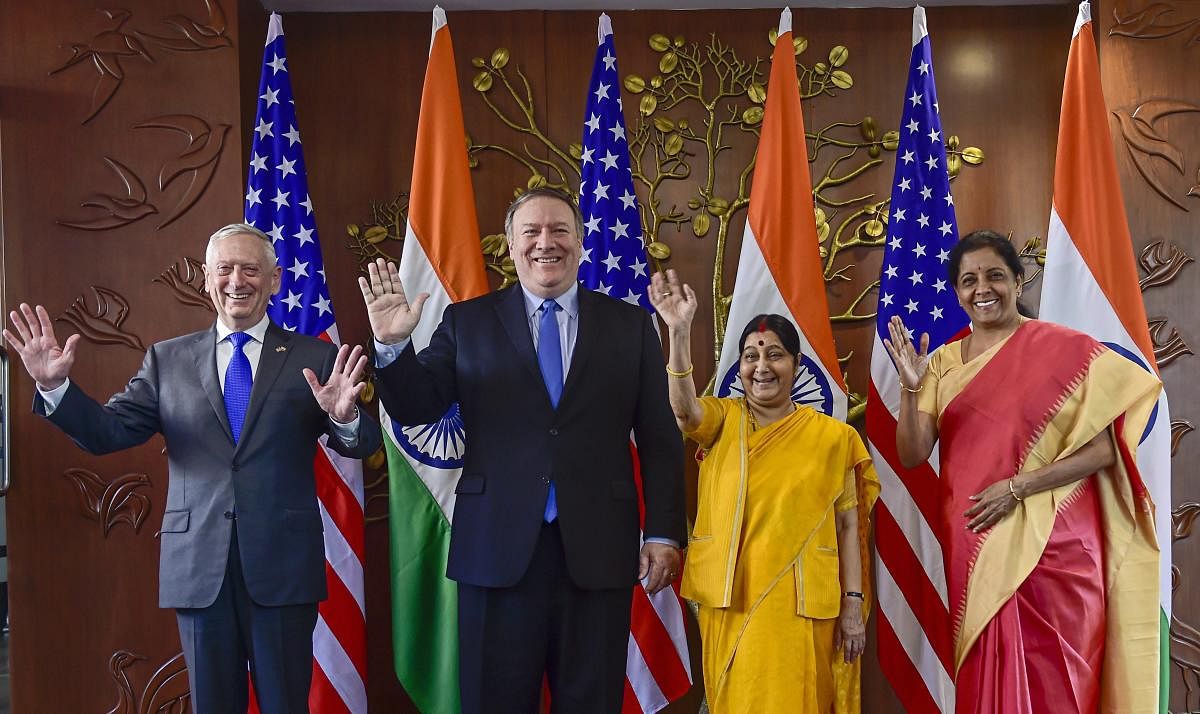
The “2+2” talks between India and the US have resulted in India signing the Communications Compatibility and Security Agreement (COMCASA), following the Logistics Exchange Memorandum of Agreement (LEMOA) in August 2016.
LEMOA and COMCASA and the Basic Exchange and Cooperation Agreement for Geo-spatial Cooperation (BECA), which is yet to be signed, form the ‘trinity’ of foundational pacts that America signs with countries with which it has close military ties. They unequivocally subordinate India’s military to the world’s most powerful military. They permit the US military a foothold on Indian soil.
These agreements are the outcome of the US-India strategic partnership framework which was crafted by America when Manmohan Singh was prime minister and George W Bush was US president. The framework agreement on nuclear cooperation was the Trojan horse that hid other strategic agreements in its belly.
One must recall that Singh had even staked his post of PM to ensure that the Trojan horse was pulled in through India’s political-economic gates. Indeed, Bush had exhorted Singh to “soldier on” against internal opposition in India to the nuclear deal. Thus, Congress’ reported dissent against the present government signing COMCASA, contending that it undermines India’s strategic autonomy, is little more than politicking and doublespeak, although the reason may well be correct.
LEMOA enforces reciprocally providing military logistic support, including use of infrastructure and facilities — seaport (harbour), airport, refuelling, repair and maintenance facilities, and staging-rest-recuperation facilities for war-weary US soldiers and sailors. LEMOA will enable the US and India to reciprocally avail logistic support for their land, sea and air forces. In this scenario, the asymmetry of interests is obvious, except to the blind or blinkered. We would clearly give much more than we may ever need and provide a “friendly” military foothold on Indian territory. While COMCASA may help India track China’s Indian Ocean moves better, LEMOA gives far more than mere
logistic cover.
It is also apt to note that US troops’ presence on leave and rest in India as a result of LEMOA may produce results like their presence has in Japan, Philippines and even European countries. India can ill-afford the inevitable social pressures of burly, sex-starved US troops flush with dollars and a sense of superiority, mingling with India’s population.
Year 1639: Damerla Venkatadri Nayak, a subordinate ruler in the Vijayanagar Empire during its decline, signed a firmaan on August 22, 1639, granting certain rights and privileges to the English East India Company, represented by Capt Francis Day. The firmaan was an agreement drafted by Francis Day and signed by the Nayak, which gave the English East India Company territorial, trading and fiduciary rights, including construction of a fort. The Nayak, “to make more full expression of our affection to the English nation,” sanctioned to the British “full power and authority to govern and dispose of the Government of Madraspatam for the term and space of two years,” and went on to offer trade concessions. He even let the British to set up their own economic system, saying, “the said English Company shall perpetually enjoy the privileges of mintage without paying any dues or duties whatsoever.” This eventually resulted in the English East India Company, arguably one of the world’s most successful business-trading corporations, expanding its sub-continental foothold through a combination of intrigue, cheating and military force, to make India the “jewel in the crown” of the British monarch for two centuries.
Strategic possibilities
The India-built Chabahar port is located on Iran’s southern coast at the top of the Arabian Sea, west of the China-built Gwadar port on Pakistan’s coast. Its construction was India’s strategic initiative to secure fuel supply through an oil/gas pipeline from Central Asia, bypassing the territory of a perennially inimical and untrustworthy China-backed Pakistan. Besides, Chabahar is closer to the mouth of the Gulf than Gwadar, and therefore is a superior strategic location to monitor and ensure oil supplies.
The signing of LEMOA, almost exactly 377 years to the day after Damerla Venkatadri Nayak signed his firmaan, may entitle military logistical support for the American military in India-built Chabahar port in Iran. India’s historically good relations with Iran, already sullied by the US-Iran relationship, will fall into dire straits if the US demands LEMOA facilities in Chabahar or even in India’s western naval bases or in India’s military air fields. This can lead to oil supply from Iran drying up, raising India’s fuel costs (already at an all-time high) even further, worsening India’s economic situation. Besides, apart from further dependence on the US, this can only escalate the militarisation of the littoral states of the Arabian Sea, to the detriment of India and the entire region.
The long-term negative strategic implications of signing LEMOA and COMCASA (and perhaps inevitably BECA later) have apparently been sidelined by the promise of immediate gains, which mostly accrue to corporate entities. One cannot help but remember the ‘firmaan’ signed 339 years ago and its consequences.
(The writer is a retired Major General of the Indian Army)